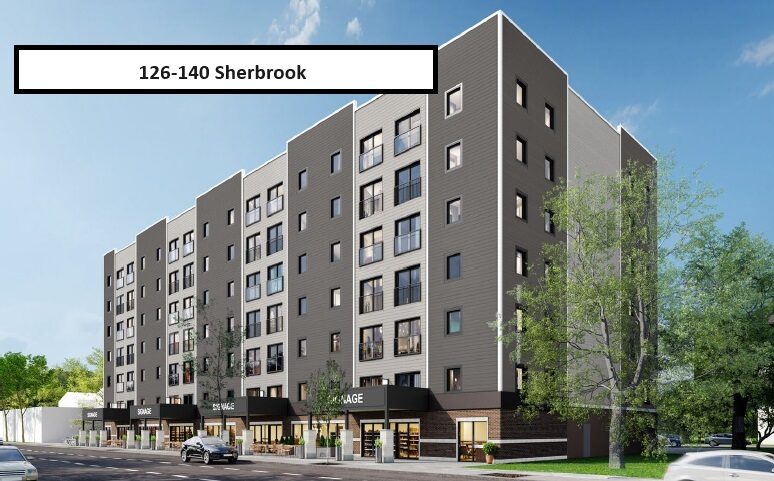Public Hearing: 126-140 Sherbrook Development Proposal
March 28, 2024

What’s proposed?
Seven-storey mixed use development including 102 residential units and 7 commercial spaces. The residential composition will include 18 bachelors, 54 one-bedrooms, 18 two-bedrooms, and 12 three-bedrooms.
38 apartments have been proposed as “affordable housing” under CMHC’s MLI Select program. This threshold is set as $1,100 and will apply to bachelor and one-bedroom units.
Full reports are included on the Community Committee Agenda: https://clkapps.winnipeg.ca/DM...
What’s being considered at the Public Hearing on April 4th?
- A consolidation of lots 126 to 140 Sherbrook Street.
- A rezoning from Commercial (C2) to Residential Mixed-Use District (RMU PDO-1).
- Demolition of four buildings including residential units and a business. These include 4-6 rental units and one single family home.
- Increased density for the provision of affordable housing (to include a minimum 33 units of affordable housing).
- Reduced parking requirements (41 instead of 102 stalls) for the provision of affordable housing.
What is West Broadway Community Organization’s position?
The development has a good mix of apartments sizes, and it is valuable to have a building with elevator access. However, the current proposal does not serve the West Broadway community’s housing needs. We believe the development should not be considered as “affordable housing” and as such, should not receive density bonusing and parking exemptions that are dedicated to affordable housing projects.
We propose one of two solutions:
- That the developer meets all design requirements of a typical market rate development, or
- That the developer makes use of available funding programs to deliver a minimum of 30% of units below 80% of Median Market Rates.
Our rationale:
A typical definition of affordable housing is that it should cost no more than 30% of a household’s after-tax income. For a household to afford one of 126-140 Sherbrook’s “affordable” units, their income would need to be at least $44,000. 76% of West Broadway’s residents have incomes below $40,000 and would not find these apartments affordable.
Of the 13% of residents with incomes over $50,000 who could comfortably afford the “affordable” apartments, few are looking for housing. Most of this population are either homeowners or are comfortably housed elsewhere in the market. For those who do have trouble finding housing in West Broadway, even the “affordable” apartments will be unattainable.
Another standard measure is that affordable housing should be no more than 80% of the Median Market Rate for similar housing in the area. This is how that would look in West Broadway:
Median Market Rates: 80% of MMR:
Bachelor - $653 Bachelor - $542
One Bedroom - $854 One Bedroom - $683
Two Bedroom - $1,038 Two Bedroom - $830
126-140 Sherbrook's affordable units do not meet West Broadway’s local housing needs. $1,100 bachelor units are nearly twice the rate of standard measures of affordability. This development should not be branding itself as an affordable project, nor should it receive planning benefits as such.
How does the development meet goals from the West Broadway Housing Plan 2021-2026
Strategy A: Encourage Development that builds a complete and sustainable community, fits with the neighbourhood and meets community needs.
- The proposed development brings added density to the neighbourhood which may help sustain local amenities and public transportation. However, as we've described above, it does not meet community housing needs.
Strategy B: Work to create new affordable housing units based on EIA rates.
- The current rent levels, even for the "affordable" apartments are beyond EIA rates. If the rent levels were set at 80% MMR, this would ensure that bachelor units are below EIA shelter rates for individuals on general assistance ($545). One bedrooms units would fall below below EIA shelter rates couples ($702).
Find the full West Broadway Housing Plan here: 2021-2026 Housing Plan
How can you engage with the development?
- Call or email Councillor Sherri Rollins to provide feedback on the proposal at [email protected] or (204) 986-5878.
- Register to speak as a delegation at City Centre Community Committee on item 3 (Subdivision and Rezoning) or item 4 (Variances). Info on how to register here: https://www.winnipeg.ca/city-governance/mayor-council/council-committee-meetings/participate-meeting
- Submit your comments in writing: https://legacy.winnipeg.ca/shared/mailforms/clerks/Delegation/contact.asp
For assistance with any of these steps, please feel free to join WBCO for a tutorial over zoom on April 2nd from 5 to 7pm.
Email [email protected]
for the meeting link.
For further thought:
Why should there be community support for a development where the existing residents cannot find a place to live within it? There is an assumption that the project will bring high-income earners to the neighbourhood to support businesses and bring more foot traffic to the area.
Until recently, vacancy rates in West Broadway were as high as 10.7%, which was most pronounced in the higher-rent apartment buildings. The last year has marked the beginning of a housing availability crisis where vacancy rates have dropped below 2% across Winnipeg. More people are forced to compromise their budget, or even their choice of neighbourhood, just to find housing. Despite this, West Broadway’s vacancies are still twice the city’s overall rate, and there continues to be higher levels of vacancy and turnover in expensive apartments.
Even if the development attracted higher-income renters from elsewhere in the city, these rates would still be unaffordable to most Winnipeggers. A median-income Winnipegger would have to dedicate 38% of their income to rent an affordable bachelor unit. The average West Broadway resident would put 49% of their income towards rent. These rates show the striking reality of shrinking vacancy rates: People are spending more and more of their income on housing costs, which leaves less money to invest in local businesses and generates greater household debt.
More worrying is the impact that this development could have on the surrounding neighbourhood. We’re concerned that introducing “affordable” apartments at this rate will lead to evictions and rent increases based on speculation throughout the neighbourhood. As we’ve already described, this is likely to shrink household budgets and harm the local economy.






